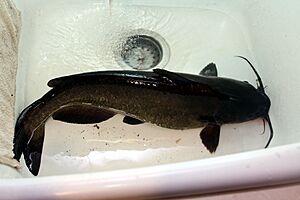Channel catfish facts for kids
Quick facts for kids Channel catfish |
|
|---|---|
 |
|
| Conservation status | |
| Scientific classification | |
 |
|
| Distribution of Ictalurus punctatus | |
| Synonyms | |
|
The channel catfish (Ictalurus punctatus) is one of the most common types of catfish in North America. It is the official fish of several U.S. states, including Kansas, Missouri, Iowa, Nebraska, and Tennessee. People often call it a "channel cat."
In the United States, channel catfish are very popular for fishing. About 8 million people fish for them each year. Because so many people like to eat channel catfish, they are also raised on farms. This is called aquaculture. Channel catfish have also been introduced to other parts of the world, like Europe, Asia, and South America. In some places, they are considered an invasive species, meaning they can harm the local environment.
Contents
Where Channel Catfish Live
Channel catfish are originally from North America. You can find them across lower Canada, the eastern and northern United States, and parts of northern Mexico. They have also been introduced to places like the Czech Republic, Romania, Malaysia, and Indonesia.
These fish can live in many different places. They like small and large rivers, reservoirs, natural lakes, and ponds. Channel catfish are "cavity nesters." This means they lay their eggs in hidden spots like cracks, hollows, or under debris. This helps protect their eggs from strong water currents. In Canada, they mostly live in the Great Lakes area.
Amazing Senses of the Channel Catfish
Channel catfish have incredibly sharp senses of smell and taste. Their nostrils have special organs that are very sensitive to smells. They can even detect tiny amounts of certain chemicals in the water.
What's even cooler is that channel catfish have taste buds all over their bodies! These taste buds are especially thick on their four pairs of barbels, which are like whiskers around their mouth. There are about 25 taste buds in every square millimeter on their whiskers. These amazing senses help channel catfish find food easily, even in dark or muddy water. They also have a special inner ear part that helps them hear sounds they might not otherwise notice.
How Big Do Channel Catfish Get?
Channel catfish can grow quite large. They can reach a weight of about 40 to 50 pounds (18 to 23 kg). The biggest channel catfish ever caught weighed 58 pounds! It was caught in South Carolina in 1964.
Catching a channel catfish over 20 pounds (9 kg) is very rare and exciting for anglers. Most people who fish for them are happy to catch a 10-pound (4.5 kg) fish. On average, you might expect to find channel catfish weighing between 2 and 4 pounds in most waterways.
Channel catfish often live in the same waters as their relatives, the blue catfish. Blue catfish are less common but can grow much bigger, sometimes over 100 pounds!
What Channel Catfish Eat
Channel catfish are omnivores, meaning they eat both plants and animals. Their amazing sense of taste helps them find food. They are sometimes called "swimming tongues" because they have taste buds all over their bodies.
Their Diet
Adult channel catfish, which are over 17.7 inches (45 cm) long, eat other fish like yellow perch and sunfish. They also enjoy snails, clams, crayfish, snakes, frogs, insects, and aquatic plants. Sometimes, they even eat algae, seeds, grains, nuts, and occasionally small birds or mammals. Younger channel catfish eat a wide variety of plants and animals.
How Channel Catfish Communicate
Channel catfish live in waters that can be dark or muddy. They don't rely only on seeing things. Instead, they use their senses of smell and touch a lot. They also use sounds to talk to each other and to warn off predators.
Talking with Chemicals
Channel catfish can produce and recognize special chemicals called pheromones. These pheromones are like secret messages. A catfish can use them to tell the species, sex, age, size, and even the social status of another catfish.
If a channel catfish is defending its territory, its body odor might change. This chemical change in their skin mucus can be noticed by other catfish. These changes don't last long, just enough to tell other fish nearby what's happening. If a catfish gets hurt during a fight, special cells in its skin might release these chemicals. Since catfish have a social order, these chemical signals help them know who is in charge.
Making Sounds
All types of catfish can make sounds. They do this in two main ways:
- Stridulation: This is like clicking or grinding. They rub bony parts of their pectoral fins (the fins on their sides) against their shoulder bones.
- Drumming: Some catfish use special muscles to make their swim bladder (a gas-filled sac inside them) vibrate, which creates a drumming sound.
Channel catfish only make sounds by stridulation. They don't have the special drumming muscles. However, their swim bladder still helps them hear better. Sound travels much faster and farther underwater than in the air. So, making sounds by rubbing bones is a great way for channel catfish to communicate underwater.
The pectoral spine of a channel catfish is a strong, bony fin ray. When the fish moves this spine, it rubs against a rough part of its shoulder, making clicking sounds. These sounds can be different depending on how the fin moves. Different sounds might be used for different reasons, like warning predators or showing who is dominant.
Many channel catfish tend to use one fin more than the other to make sounds, just like people are right-handed or left-handed. The pectoral fin can also be locked into place as a defense against predators.
How Channel Catfish Hear
The main part of a fish's inner ear that helps it hear is called the utricle. The swim bladder makes the channel catfish's hearing even better. It acts like a drum, picking up echoes from other fish's sounds or even sonar. The swim bladder also helps them sense changes in water pressure. All these features help channel catfish hear different sounds and know where they are coming from.
Warning Predators
Channel catfish use their sounds to scare away predators. They make sudden, loud clicking sounds by rubbing their pectoral fins. This is like how some butterflies flash bright colors to startle predators. These sounds can also act as an alarm signal, warning other catfish nearby that a predator is close.
Fishing for Channel Catfish
Since channel catfish eat almost anything, you can catch them using many different kinds of bait. Popular baits include crickets, nightcrawlers, minnows, shad, freshwater drum, crawfish, frogs, bullheads, sunfish, chicken liver, hot dogs, and even raw steak. Some people even use Ivory soap!
Besides using a traditional fishing rod and reel, people also use other methods to catch channel catfish. These include juglines, trotlines, limb lines, and bank lines. Traps, like "slat traps" (long wooden traps) and wire hoop traps, are also popular. For traps, people often use smelly baits like rotten cheese, dog food, or old, rotted shad. It's common to catch as many as 100 fish a day with these traps. In the southeastern United States, some people even catch catfish by hand, a method called noodling.
When you remove a hook from a catfish, be careful! They have sharp spines on their pectoral and dorsal fins that can poke you.
Channel Catfish Genetics
The channel catfish is one of the few freshwater fish species whose complete genetic code (genome) has been mapped. Scientists studied the channel catfish genome along with other fish to understand how some fish lost their scales over time. This research helps us learn more about fish evolution.
Scientists have also studied the genetic diversity of channel catfish, especially those raised on farms compared to those in the wild. This helps improve how channel catfish are raised for food.
- Froese, Rainer, and Daniel Pauly, eds. (2011). "Ictalurus punctatus" in FishBase. December 2011 version.
See also
 In Spanish: Pez gato americano para niños
In Spanish: Pez gato americano para niños





